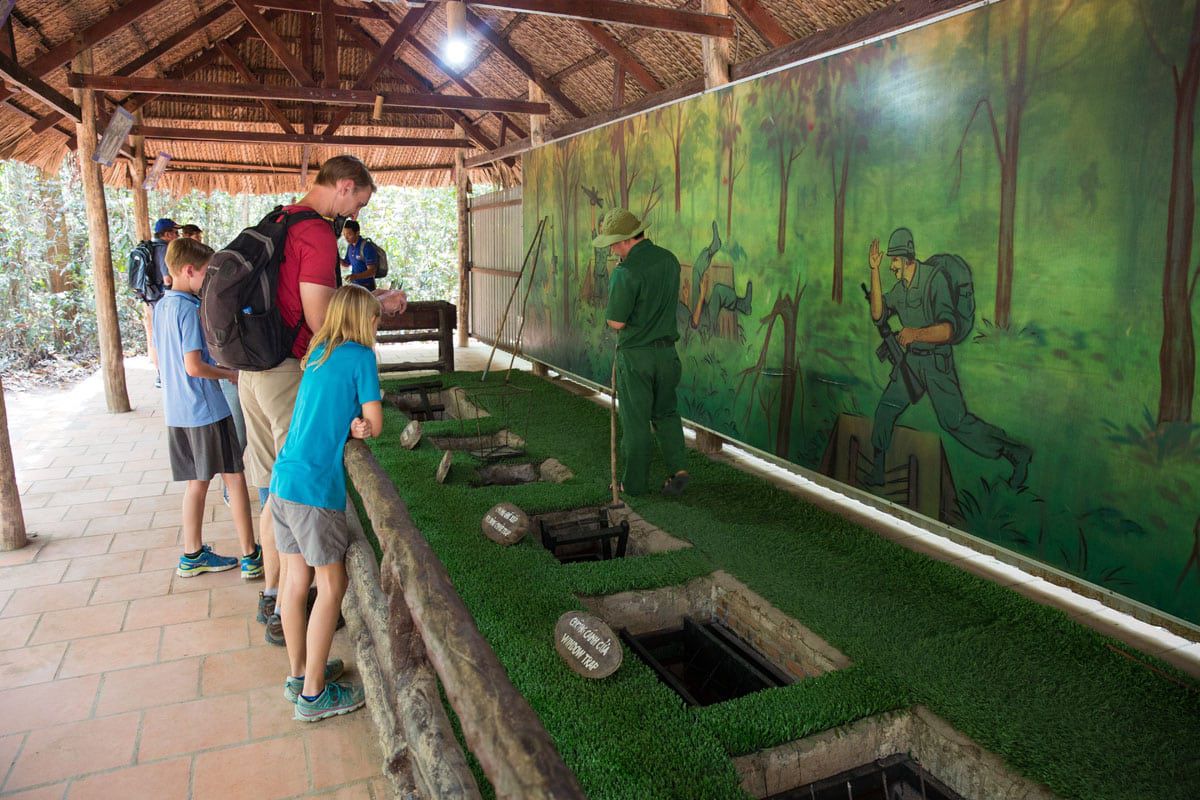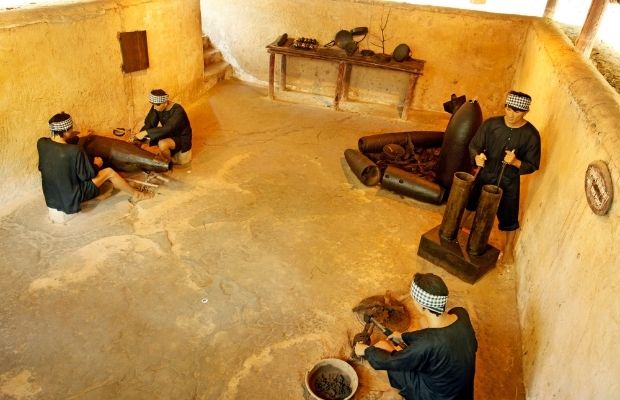Table of Contents
Nestled in the heart of Vietnam Cu Chi Tunnels history, approximately 40 kilometers northwest of Ho Chi Minh City, lies a labyrinthine network of subterranean tunnels that played a pivotal role in the Vietnam War. These tunnels, known as the Cu Chi Tunnels, have captivated the world’s attention with their strategic significance, ingenious construction, and the resilience of the Vietnamese people.
The Cu Chi Tunnels stand as a testament to the determination and adaptability of the Vietnamese in their struggle for independence. In this article, we will take a historical journey through the Cu Chi Tunnels, exploring their construction, purpose, life inside, strategic significance, tactics and techniques used, impact on the Vietnam War, preservation and tourism, controversies surrounding them, and their legacy in Vietnam.
The History of the Cu Chi Tunnels

The Vietnam Cu Chi Tunnels history, a remarkable feat of engineering, were initially constructed during the French colonial period in the 1940s as a means of concealment and communication for Vietnamese guerrilla fighters. However, it was during the Vietnam War (1955-1975) that the tunnels gained their notoriety and became a symbol of Vietnamese resistance against foreign aggression.
Construction and Purpose of the Cu Chi Tunnels

The Cu Chi Tunnels were built by the Vietnamese communists, known as the Viet Cong, to counter the superior firepower and technology of the United States and its allies. The initial tunnel system was small and primitive, but as the war progressed, it underwent massive expansion and fortification.
The tunnels were dug by hand using simple tools such as shovels, hoes, and pickaxes. The soil was then removed and hidden in nearby fields or used to create booby traps. The tunnels were strategically designed with multiple levels, including living quarters, storage facilities, hospitals, kitchens, meeting rooms, and even schools.
The purpose of the tunnels was to provide shelter and protection for the Viet Cong fighters, as well as a means of transportation and communication. The tunnels also served as a base for launching surprise attacks on the enemy and as a supply route for weapons and supplies.
Life Inside the Vietnam Cu Chi Tunnels history
Life inside the Cu Chi Tunnels was not easy. The tunnels were dark, cramped, and infested with insects and vermin. The air was stale and often filled with the smell of smoke from cooking fires. The living conditions were harsh, with limited food and water supplies.
Despite these challenges, the Vietnamese fighters adapted to their underground lifestyle and made the best of their situation. They used innovative techniques such as bamboo ventilation pipes and camouflaged trap doors to maintain secrecy and protect themselves from enemy attacks.
The Viet Cong fighters also had to be constantly on guard against the threat of American soldiers discovering and destroying their tunnels. To counter this, they built multiple escape routes and booby traps, making it difficult for the enemy to navigate and attack.
Strategic Significance of the Cu Chi Tunnels in the Vietnam War

The Vietnam Cu Chi Tunnels history played a crucial role in the Vietnam War, serving as a key element in the Viet Cong’s strategy of guerrilla warfare. The tunnels provided a safe haven for the Viet Cong fighters, allowing them to launch surprise attacks on the enemy and then disappear into the tunnels before the Americans could retaliate.
The tunnels also served as a vital supply route for the Viet Cong, enabling them to transport weapons, ammunition, and supplies without being detected by the enemy. This gave them a significant advantage over the American troops, who relied heavily on their advanced technology and firepower.
Moreover, the Cu Chi Tunnels were strategically located near important targets such as military bases, roads, and rivers, making them an ideal base for launching attacks and disrupting the enemy’s operations. The tunnels also served as a communication network, allowing the Viet Cong to coordinate their movements and strategies.
Tactics and Techniques Used in the Cu Chi Tunnels
The Viet Cong used various tactics and techniques to defend and maintain the Cu Chi Tunnels. One of the most effective methods was the use of booby traps. These traps were designed to maim or kill American soldiers who stumbled upon them while searching for the tunnels.
Some of the most common booby traps included punji sticks, which were sharpened bamboo stakes hidden in the ground, and tripwire explosives, which were triggered by a wire stretched across a path. These traps not only caused physical harm but also instilled fear and demoralized the enemy.
Another tactic used by the Viet Cong was the creation of fake tunnel entrances to confuse the Americans. These decoy tunnels would lead to dead ends or be rigged with booby traps, wasting the enemy’s time and resources.
The Viet Cong also used psychological warfare to their advantage. They would play recordings of animal noises or use smoke to create the illusion of a large enemy presence, causing the Americans to hesitate and waste ammunition on non-existent targets.
Impact of the Cu Chi Tunnels on the Vietnam War
The Cu Chi Tunnels had a significant impact on the outcome of the Vietnam War. The tunnels allowed the Viet Cong to continue their resistance against the American forces despite being heavily outnumbered and outgunned.
The tunnels also forced the Americans to change their tactics and strategies, as they struggled to combat an enemy that could disappear into the ground at any moment. This led to the development of new technologies such as tunnel rats, specially trained soldiers who would enter the tunnels to gather intelligence and destroy them from within.
Moreover, the Cu Chi Tunnels became a symbol of Vietnamese resilience and determination in the face of foreign aggression. The tunnels showed the world that the Vietnamese were not afraid to fight for their independence and would do whatever it takes to defend their homeland.
Preservation and Tourism of the Cu Chi Tunnels
After the Vietnam War ended, the Cu Chi Tunnels were preserved as a historical site and opened to the public in 1988. Today, the tunnels are one of the most popular tourist attractions in Vietnam, attracting thousands of visitors each year.
Tourists can explore a small section of the tunnels, which have been widened and reinforced for safety. They can also see various traps and weapons used by the Viet Cong, as well as displays and exhibits showcasing the daily life of the Vietnamese fighters during the war.
The preservation and tourism of the Cu Chi Tunnels not only provide an insight into the history of the Vietnam War but also contribute to the local economy and help educate future generations about the country’s past.
Controversies Surrounding the Cu Chi Tunnels
Despite its popularity, the Cu Chi Tunnels have also faced controversies. Some critics argue that the tunnels have been overly commercialized and that the exhibits and displays are exaggerated for the sake of tourism.
There have also been concerns about the safety of tourists exploring the tunnels, as well as the impact of increased tourism on the surrounding environment. However, efforts have been made to address these issues, such as implementing safety measures and promoting sustainable tourism practices.
Legacy of the Cu Chi Tunnels in Vietnam
The Cu Chi Tunnels hold a significant place in Vietnam’s history and continue to be a source of pride for the Vietnamese people. The tunnels serve as a reminder of the country’s struggle for independence and the resilience of its people.
Moreover, the Cu Chi Tunnels have become a symbol of ingenuity and perseverance, inspiring future generations to overcome challenges and obstacles with determination and adaptability.
Conclusion
The Vietnam Cu Chi Tunnels history are more than just a network of underground passageways. They are a testament to the strength and resilience of the Vietnamese people, who used their ingenuity and determination to defend their homeland against foreign aggression.
The tunnels played a crucial role in the Vietnam War, serving as a base for the Viet Cong’s guerrilla warfare tactics and disrupting the enemy’s operations. Today, the Cu Chi Tunnels stand as a historical site and a popular tourist attraction, preserving the memory of the Vietnamese struggle for independence and educating visitors about the country’s past.
The legacy of the Cu Chi Tunnels will continue to live on, reminding us of the power of human perseverance and the importance of preserving our history for future generations.